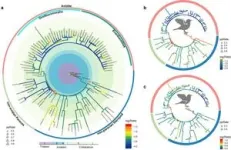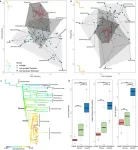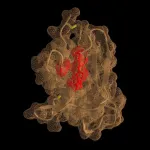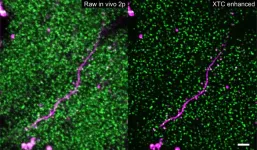BRIDGEcereal: Self-teaching web app improves speed, accuracy of classifying DNA variations among cereal varieties
2023-06-05
(Press-News.org)
Kim Kaplan
301-588-5314
Kim.Kaplan@usda.gov
BRIDGEcereal: Self-Teaching Web App Improves Speed, Accuracy of Classifying DNA Variations Among Cereal Varieties
PULLMAN, WA, June 5, 2023—Agricultural Research Service and Washington State University scientists have developed an innovative web app called BRIDGEcereal [https://bridgecereal.scinet.usda.gov/] that can quickly and accurately analyze the vast amount of genomic data now available for cereal crops and organize the material into intuitive charts that identify patterns locating genes of interest.
With the rapid advancements in the field of genomics the past 25 years, a game-changer for crop improvement has emerged referred to as the pan-genome, defined as the assembled genome sequences from multiple varieties within a species. But understanding and enhancing crops based on the huge amount of data that have been generated also has created a challenge for researchers due to the lack of efficient and user-friendly bioinformatic tools, particularly ones designed to handle large volume DNA variations in a species.
Take wheat, for example. The standard reference wheat genome—which was done for the wheat variety Chinese Spring—is five times larger than the human genome. In addition, researchers have long struggled with the wide variation in the locations of genes that control essential agronomic traits across wheat’s 21 chromosomes. Right now, a dozen wheat genomes are publicly available.
This adds up to a huge amount of data, making analysis of it a tedious process even for researchers with advanced bioinformatic skills. It is particularly challenging to sort through all of the data to identify similar stretches of DNA that may control the same trait no matter where they are located on a chromosome.
BRIDGEcereal is designed to transform the process of identifying large DNA variation from tedious to efficient.
“By simply providing BRIDGEcereal with the sequence of DNA you are interested in, it will complete the search process in less than one minute.” explained ARS research biologist Xianran Li, leader of the BRIDGEcereal project. Li is with the ARS Wheat Health, Genetics, and Quality Research Unit in Pullman, Washington.
“And BRIDGEcereal will organize the data it finds and present it to you in easily understood charts that highlight any patterns of where that DNA is,” Li added.
It only took a minute for BRIDGEcereal to identify a promising candidate gene as the controller of a wheat mutation that reduces the length of awns, the bristle-like extensions from the wheat grain head. It had been known since the 1940s that a gene on wheat chromosome 4A controls awn development, which is an iconic wheat trait. But the exact gene controlling that trait has remained unknown.
“By searching dozens of potential genes through BRIDGEcereal, we were able to quickly identify a gene with a large DNA variation as the one that has been eluding researchers,” Li said.
The scientists also designed BRIDGEcereal to be self-teaching--also called unsupervised machine-learning--meaning BRIDGEcereal can autonomously learn to recognize new patterns without the need for explicit instructions to follow.
“So what we’ve developed is a one-stop gateway to efficiently mine publicly accessible cereal pan-genomes that will only get more efficient as the data continues to mount up,” Li said.
Bosen Zhang, a postdoctoral research associate with Washington State University and co-developer of the web app, added, “Researchers will find BRIDGEcereal to be an invaluable tool for selecting and prioritizing candidate genes that control specific traits in cereal crops.”
BRIDGEcereal was first developed to work with wheat. It has already been adapted to analyze similar data from barley, maize, sorghum, and rice.
This research was published in the journal Molecular Plant [https://doi.org/10.1016/j.molp.2023.05.005 this will change and I will update Monday morniing when journal provides].
The Agricultural Research Service is the U.S. Department of Agriculture's chief scientific in-house research agency. Daily, ARS focuses on solutions to agricultural problems affecting America. Each dollar invested in U.S. agricultural research results in $20 of economic impact.
#
END
[Attachments] See images for this press release:


ELSE PRESS RELEASES FROM THIS DATE:
2023-06-05
About The Study: This survey study found that 28% of youth-serving U.S. mental health facilities offered LGBTQ-specific mental health services in 2020. Although some states had relatively high levels of LGBTQ service availability as a percentage of facilities, many of these states had few facilities available to children per capita. Public mental health facilities were less likely to offer LGBTQ-specific mental health services, a concern given that the cost of care is a barrier to services. The findings suggest a need to expand availability of LGBTQ services ...
2023-06-05
New research has revealed being active could lower the risk of type 2 diabetes, even in people with a high genetic risk of developing the medical condition.
The University of Sydney-led study found higher levels of total physical activity, especially moderate- to vigorous-intensity physical activity, had a strong association with a lower risk of developing type 2 diabetes.
The findings were published in the British Journal of Sports Medicine.
The researchers say the study demonstrates higher levels of physical activity should be promoted as a major strategy for type 2 diabetes ...
2023-06-05
Researchers who lead the world’s first comprehensive sequencing program for newborn infants have published the next chapter in the ongoing study of the BabySeq Project, with new findings on infants and families who have been followed for 3-5 years. In a study published today in the American Journal of Human Genetics, researchers from Mass General Brigham and Boston Children’s Hospital reported that over 10 percent of the first 159 infants to undergo screening through DNA sequencing were discovered ...
2023-06-05
DURHAM, N.C. – Tirzepatide, a drug approved for diabetes and on the fast track for approval as a weight loss therapy, works through a unique ability to activate two different mechanisms the body uses to control insulin secretion and energy balance, Duke Health researchers report.
The finding, reported June 5 in the journal Nature Metabolism, is the first study to use cells from human donors to demonstrate how tirzepatide stimulates insulin secretion, an important action utilized by this drug to lower blood glucose in patients with type 2 diabetes.
“Understanding the potential of drugs ...
2023-06-05
CHICAGO – Patients with early relapsed or refractory large B-cell lymphoma had significantly improved overall survival when treated with the chimeric antigen receptor (CAR) T cell therapy axicabtagene ciloleucel (axi-cel) when compared to the current standard-of-care chemoimmunotherapy, according to results of the Phase III ZUMA-7 trial reported by researchers from The University of Texas MD Anderson Cancer Center.
Data from the study were presented today by Jason Westin, M.D., director of clinical research in the Department of Lymphoma and Myeloma, at the 2023 American Society of Clinical Oncology (ASCO) Annual Meeting and published concurrently in ...
2023-06-05
Women have long searched for remedies for the bothersome hot flashes that often come with menopause.
In a novel investigation, researchers at UC San Francisco tested the benefits of continuously wearing a nitroglycerin patch – an established treatment for chest pain from coronary artery disease – for menopausal women experiencing at least seven hot flashes a day. Unlike most treatments for hot flashes that target brain mechanisms, nitroglycerin works on blood vessels throughout the body.
The results were mixed. While ...
2023-06-05
The assembly of the volant bird body plan from the ancestral bulky dinosaurian condition is an enduring topic of evolutionary biology. The body plan of volant birds demonstrates a pronounced decrease in body size and proportionate elongation of the forelimbs. Given the scaling relationship between limb and body size, changes to the former were likely clouded by changes to the entire body size.
Since changes to individual limb elements provides the direct basis for natural selection, they are essential to comprehending branch- and lineage-specific evolutionary patterns across the transition from terrestrial to ...
2023-06-05
How do today’s indigenous communities of South America trace back to the history of human migration and contact in the continent? An international team has worked to reconstruct the legacy of Chile’s largest indigenous community, the Mapuche, in a quest to strengthen their representation in the history of the continent. It appears the Mapuche long lived in relative isolation but do bear some influences from other populations of the Central Andes and the far south of Chile.
South America was the last continent ...
2023-06-05
LA JOLLA, CALIF. – June 5, 2023 – Researchers at Sanford Burnham Prebys, collaborating with scientists from Eli Lilly and Company, have revealed the structure and function of a drug called LY3361237, which can reduce the harmful activity of the immune system to help treat autoimmune diseases. Their work laid the foundation for a new treatment that’s currently in a Phase 2 clinical trial for lupus, an autoimmune disease affecting multiple organs in the body. The study is published in Structure, a Cell Press journal.
The ...
2023-06-05
FOR IMMEDIATE RELEASE
Johns Hopkins scientists have developed a method involving artificial intelligence to visualize and track changes in the strength of synapses — the connection points through which nerve cells in the brain communicate — in live animals. The technique, described in Nature Methods, should lead, the scientists say, to a better understanding of how such connections in human brains change with learning, aging, injury and disease.
“If you want to learn more about how an orchestra plays, you have to watch individual players over time, and this ...
LAST 30 PRESS RELEASES:
[Press-News.org] BRIDGEcereal: Self-teaching web app improves speed, accuracy of classifying DNA variations among cereal varieties





